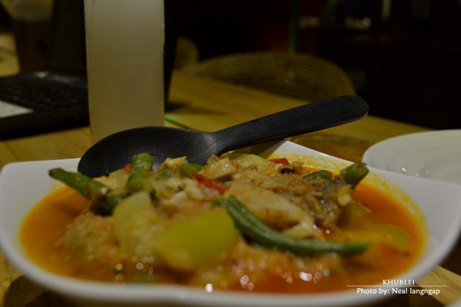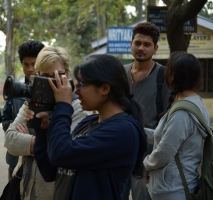I have been an admirer of Indrani Raimedhi’s short-stories written in English. She possesses the sensibility of an authentic writer, is a perceptive observer of people and their foibles and the skills to structure a narrative as is demanded by the short-story form. However, the pieces in this compilation are of a different genre altogether --- written perhaps with a newspaper readership in view, they are a type of continual and intimate tete-a-tete between the writer and the reader. This is an ‘old school’ approach adopted by so many pioneering essayists since the Augustan period in English literature, one which helped immensely in the transition from poetry to prose as the predominant mode of literary communication.
It, in fact, is a favourite genre of mine --- I recall that during my adolescent days most columnists spoke directly to the reader, thereby creating an empathy which few of the current breed can attain. However, despite the seeming simplicity of the approach and the ordinariness of themes, the genre is a difficult one, requiring that the writer possesses an eclectic temperament enabling her or him to speak about anything under the sun in a normal, conversational tone without being pedantic. Yet there is great knowledge, depth of reading and a sensibility which can as facilely make observations about the work of a master artist or great writer, as the plebeian experience of attending a wedding at a metro like Guwahati.
Every page of this book testifies to the fact that Indrani Raimedhi possesses the required urbane sensibility and the tools of her craft to convey her thoughts to paper. “Whether it is Ismat Chughtai, Maya Angelou or Virginia Woolf, literature for women has never been an idle pastime, a fashionable talking point but a means of protest, a flaming torch to dispel the darkness of their existence, a way of rattling the cage as it were. That is why the feminine pen is often dipped in acid, and every word is like the rush of wings upwards to a free and boundless sky….. In the early part of the twentieth century, Edward Bernays, the nephew of Sigmund Freud, made it his business to use psychological principles of mass persuasion to serve the interests of capitalism in America…..”
Throughout the book, as one thought leads to another, the broad range of the writer’s reading as also her aesthetic sensibility, peeps out of every page, giving a depth to her musings. For instance, in the essay “Islands of Being,” there are references to John Donne, John Steinbeck, Haruki Murakami, Herman Hesse, Greta Garbo and Emily Dickinson, all in the space of a few paragraphs. In some of the pieces there is a juxtaposition of the literary and non-literary, word-images culled both from high-culture and mass-culture which go to make a unique style of writing.
“The moon is often a serene and ubiquitous presence in mythology and literature,” I quote in detail from her piece titled ‘Over the Moon.’ “If Pink Floyd named their album Dark Side of the Moon, Anton Chekhov remarked, “I promise to be an excellent husband, but give me a wife who, like the moon, will not appear every day in the sky.” The great American poet Carl Sandburg described the moon “as a friend for the lonesome to talk to.” D. H. Lawrence expressed a sentiment I heartily endorse: “The moon! Artemis! The great Goddess of the splendid past of men. Are you going to tell me she is a dead lump?” Somerset Maugham based his Moon and Sixpence on the life of the artist Paul Gauguin. A tenth century Japanese tale describes how the Moon Princess comes to live with a bamboo cutter couple. In the Italian romantic epic Orlando Furioso, the moon is depicted as the place where everything lost on earth is found. J. R. R. Tolkein, trying to console his four-year-old son Michael grieving the death of his dog, wrote Roverandom, a story about a dog’s adventures on the moon….”
However, it is not at all a rabidly West-oriented litany of references, for the writer does not hesitate to cite Indian references as well. In the same piece of writing, we have “In one of his verses, Kalidasa requests his patron King Bhojaraja to provide him with a sumptuous meal that includes curd made from buffalo milk resembling moonlight after the monsoon season. The moon has had a long innings in Indian cinema, as a prop in dance sequences, fitted into lovelorn lyrics, used as a vehicle to express loss and despair. Whether it was Raj Kapoor romancing with Nargis in Awara or Raj Kumar communing with Meena Kumari in Pakeezah, the moon was a vital element in celluloid magic…..”
Reading the pieces, one constantly shuttles between the profound and the prosaic, lured into Raimedhi’s musings by the flow of her words. One of the measures of a confident writer is not hesitating to slide into humour, which she does every now and again. As an example can be taken the piece ‘A Toast to the Sole’ in which she articulates her belief that “a pair of women’s sandals carelessly abandoned, as if in a moment of great desperation, seems to hint at some dark, Chekhovian tale involving a young, beautiful but foolishly naïve protagonist and her life of chaotic turmoil,” and her being able to “imagine indignant and rebellious subjects (of the Prince in the Cinderella story) subjects finally marching to the palace and giving him a George Bush and Suresh Kalmadi kind of shoe treatment.”
The assuredness of her style and her feel for semantic nuances make Indrani Raimedhi an outstanding writer, whether it be in her short stories or pieces like the ones in this compilation.







































